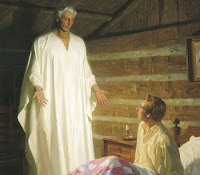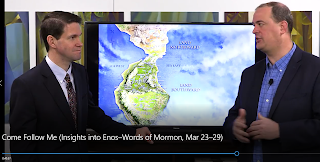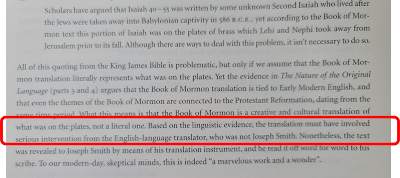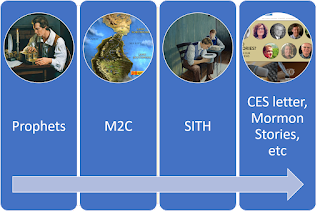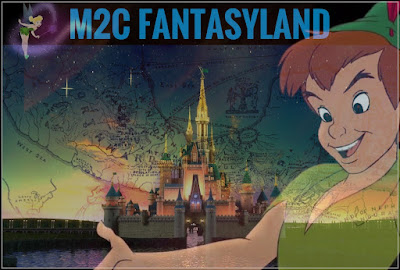Scholars vs prophets and multiple working hypotheses
The discussion about the New York Cumorah presents people with a simple, clear choice about whom you follow and how you interact with the scriptures, particularly the text of the Book of Mormon but also the Doctrine and Covenants and Pearl of Great Price.
Choice 1: Scholarly, subjective speculations about the text and extrinsic evidence that guide our interpretation of the location of Cumorah.
Choice 2: Prophetic, factual statements about Cumorah in New York that guide our interpretation of the text and extrinsic evidence.
In the case of Cumorah, it makes an enormous difference which choice we make. If we accept the teachings of the scholars, we reject the teachings of the prophets. If we accept the teachings of the prophets, we reject the teachings of the scholars. There is no middle ground on this point. It’s a binary, either/or choice. The Cumorah of Mormon 6:6 is either in western New York, or it’s elsewhere. And if the prophets were wrong about the New York setting, it doesn’t really matter where the “real Cumorah” is.
It’s a bizarre “tail wags the dog” scenario. The scholars insist the prophets are wrong solely because of their subjective speculations about where the Nephites must have lived, which leads them to develop “criteria” for Cumorah based on extrinsic evidence from their speculations. For example, because they insist the Nephites lived in Mesoamerica, they also insist Cumorah must be in a land of volcanoes, even though the text never mentions volcanoes. They insist Cumorah must be in a place inhabited by millions of ancient people, even though the text never says or implies that was the case.
When we read what the text actually says, as opposed to what commentators have said about what the text says, it’s easy to reconcile the teachings of the prophets about Cumorah with the extrinsic evidence. For example, we can see that population estimates based on the text are congruent with extrinsic evidence from archaeology and anthropology in western New York, Ohio, etc. I discussed some of that here:
http://www.lettervii.com/2021/03/book-of-mormon-populations.html
_____
Discussions about history involve two elements:
A. Historical facts (documents and extrinsic evidence). Because we’re dealing with history, and no one is claiming any new revelation about that history, everyone is on a level playing field. No one has “special knowledge” about history because of their experience, credentials, positions, etc. Anyone who can read and understand English has equal access to all the facts.
B. Interpretation of those facts (multiple working hypotheses). This is where it is easy to get confused. Often, historians write in a style that presents their hypotheses as facts. Obviously, they have no personal knowledge of historical facts; they rely on evidence just like everyone else. This is a standard persuasive technique, but don’t accept historians’ statements as fact without seeing the evidence they rely upon. In the context of Church history, historians who are both believers and unbelievers use this rhetorical style. Discerning readers can tell the difference.
_____
Ideally, we first establish the facts. Everyone should be able to agree about what the facts are. Proponents often avoid, discount, or even censor facts that contradict their hypotheses, but that’s easy to expose.
For example, ask yourself, did you know that Joseph’s mother reported that Moroni identified the hill in New York as Cumorah the first time he visited Joseph Smith in 1823?
Moroni said, “the record is on a side hill on the Hill of Cumorah 3 miles from this place.”
If you don’t know that, why don’t you know that?
Ask your BYU or CES teacher. Or ask the teachers of your children or grandchildren.
It is inexcusable that Latter-day Saints don’t know about this.
As a test, if you search for that phrase on Fairlatterdaysaints.org, you get two results, here and here. Both are buried in discussions about the First Vision, and both cite Dan Vogel’s Early Mormon Documents book, volume 1, instead of the Joseph Smith Papers.
If fairlatterdaysaints.org was a legitimate educational organization instead of an advocacy front for the M2C citation cartel, they would feature Lucy’s account in their discussions of Cumorah. But they don’t and they won’t. They don’t want Church members to know about anything that contradicts M2C.
_____
Every sincere seeker of truth should be able to agree on what the facts are.
That’s the easy part.
Next, we interpret those facts to develop hypotheses that explain and reconcile the facts in various ways. This involves assessing reliability, credibility, authenticity, and other indicia of truthfulness. Much of that analysis is subjective, but that’s fine so long as we clearly explain our reasoning.
Different people develop different hypotheses that reflect their respective biases, desired outcomes, values, priorities, etc. Some people claim they “follow the evidence” but we can all see that is a delusion. The worst extreme of bias confirmation is not recognizing your own biases–or actually believing you have no bias.
To repeat: Because we’re dealing with history, and no one is claiming any new revelation about that history, everyone is on a level playing field. We all have access to all the evidence.
In this short post, I can’t list all the evidence about Cumorah (some of it is here), but readers of this blog by now are familiar with it. Really, regarding Cumorah there is very little debate about the evidence itself. The debate involves (i) disclosing and (ii) interpreting the evidence.
Here’s a table that illustrates the two separate approaches to the Cumorah issue. Most references are here: http://www.lettervii.com/p/byu-packet-on-cumorah.html
|
Facts |
Interpretation – Prophets |
Interpretation – Scholars |
|
Lucy Mack Smith: When Moroni first visited Joseph Smith, he told Joseph that “the record is on a side hill on the Hill of Cumorah 3 miles from this place.” |
Lucy was correct and this explains why everyone knew Cumorah was in New York |
Lucy was wrong because she related a false tradition, or else Moroni was referring to a “second” Cumorah because the real Cumorah is in Mexico |
|
Lucy Mack Smith: Joseph said, “as I passed by the hill of Cumorah, where the plates are” |
Lucy was correct and this explains why everyone knew Cumorah was in New York |
Lucy was wrong because she related a false tradition, or else Moroni was referring to a “second” Cumorah because the real Cumorah is in Mexico |
|
David Whitmer: The messenger who had the abridged plates declined a ride to Fayette and said “No, I am going to Cumorah.” David said, “This name was something new to me, I did not know what Cumorah meant.” |
David was correct and this explains why everyone knew Cumorah was in New York |
David was wrong because she related a false tradition, or else the messenger was referring to a “second” Cumorah because the real Cumorah is in Mexico |
|
Oliver Cowdery (quoted by Parley P. Pratt) during the mission to the Lamanites (D&C 28, 30 and 32). “This Book, which contained these things, was hid in the earth by Moroni, in a hill called by him, Cumorah, which hill is now in the State of New York, near the village of Palmyra, in Ontario County.” |
Oliver and Parley were correct and this explains why everyone knew Cumorah was in New York |
Oliver and Parley were wrong because they related a false tradition, or else the Moroni was referring to a “second” Cumorah because the real Cumorah is in Mexico |
|
Heber C. Kimball, who lived in western New York and joined the Church in 1832, visited Cumorah after his baptism and reported he could still see the embankments around the hill (most of which have since been plowed under) |
Heber was correct because he had been taught about the New York Cumorah and observed the evidence with his own eyes |
Heber was wrong because he didn’t describe the embankments in enough detail to verify his observations and because he was relying on a false tradition anyway |
|
Oliver Cowdery, then Assistant President of the Church (which meant he was Joseph’s spokesman) wrote a series of essays about Church history with the assistance of Joseph Smith, published as letters in the Messenger and Advocate, Times and Seasons, Gospel Reflector, Millennial Star, The Prophet, and the Improvement Era. Joseph also had them copied into his journal as part of his life story. Letter I. “[Moroni] said this history was written and deposited not far from that place” referring to Joseph’s home near Palmyra |
Oliver was correct. If the history was “written and deposited” not far from Joseph’s home, Mormon and Moroni lived in that vicinity when they abridged the Nephite and Jaredite records. |
Oliver was wrong because either he or Joseph misquoted Moroni based on a false tradition |
|
Letter VI. Referring to the mile-wide valley west of the hill in New York where Joseph found the plates, “here, between these hills, the entire power and national strength of both the Jaredites and Nephites were destroyed.” |
Oliver was correct because he and Joseph had visited the depository of Nephite records in the hill mentioned in Mormon 6:6 multiple times, as related by Brigham Young, Heber C. Kimball, David Whitmer, and others |
Oliver, David Whitmer, Brigham Young, Heber C. Kimball, and others were wrong because either Oliver misled people based on a false tradition or he was relating multiple joint visions of the “real Cumorah” in southern Mexico, but also Oliver and Joseph never had any revelation about Cumorah |
|
Letter VII. “[Mormon] deposited, as he says, on the 529th page, all the records in this same hill, Cumorah and after gave his small record to his son Moroni” |
Oliver was correct because he had visited that depository, so he knew exactly where it was and he explained by citing Mormon 6:6 |
Oliver was wrong because he was merely speculating based on a false tradition |
|
Letter VII. “This hill, by the Jaredites, was called Ramah: by it, or around it pitched the famous army of Coriantumr their tents.” |
Oliver was correct because he had visited that depository and knew from personal experience what it contained |
Oliver was wrong because he was merely speculating based on a false tradition |
|
D&C 128:20 (originally a letter published in the Times and Seasons in September 1842): “And again, what do we hear? Glad tidings from Cumorah! Moroni, an angel from heaven, declaring the fulfilment of the prophets—the book to be revealed.” |
Joseph was correct because he had learned the name from Moroni before he ever got the plates, he had visited the depository, and he had helped write and promulgate Letter VII, which had been published in the Times and Seasons a year previously. |
Joseph was wrong because he had adopted the false tradition about Cumorah, or else he was referring to the hill in southern Mexico because of speculative articles in the Times and Seasons that anachronistically attributed Mayan ruins to the Nephites |
|
Various other teachings by Joseph’s contemporaries and successors about the New York Cumorah |
They were correct because they relied on what Joseph and Oliver taught |
They were wrong because they relied on a false tradition, which we know is false because our interpretation of the Book of Mormon requires Cumorah to be in southern Mexico |
Source: Letter VII
